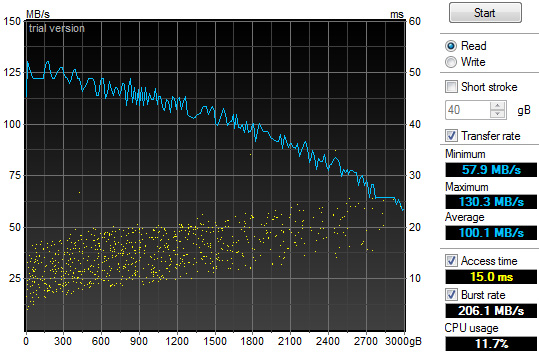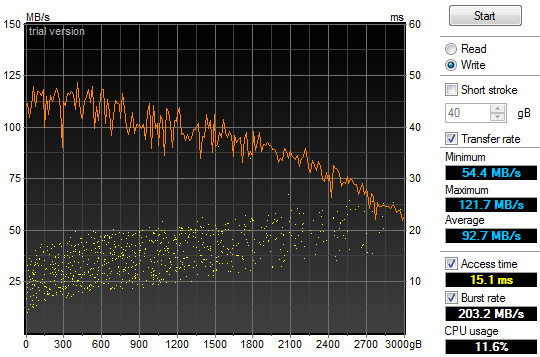Western Digital Caviar Green 3TB and My Book Essential 3TB Drives Reviewed
by Anand Lal Shimpi on October 19, 2010 1:43 PM EST- Posted in
- Storage
- HDDs
- Western Digital
- 3TB
Performance vs. Capacity
Hard drives are made up of one or more circular platters. Platters are written from the outside inward in order to maximize performance (you cover more data in a single rotation of an outer track vs an inner track). As was the case in our Seagate 3TB review I had to turn to HD Tune as HD Tach doesn't support 64-bit LBAs:

Maximum read performance is 130MB/s while maximum write speed is 121.7MB/s. The minimum speed you'll get out of the drive is ~55MB/s at its inner most tracks.











48 Comments
View All Comments
pvdw - Wednesday, October 20, 2010 - link
I use Linux MD RAID 10 (near-copies) on my home "server". For those who don't know, this is a non-standard RAID level that simulates RAID-10 using only two drives. In addition to redundancy this provides read speed improvements and some write speed improvement. I've set up automatic backups to protect from user error; and use Linux, so no viruses (yet). So I'm protected from all but fire/theft/bomb/hurricane/etc. For this I have off-site storage that syncs on a less frequent basis.Since we've had a number of power cuts here recently, the RAID setup also gives extra security.
Also, I don't know where you get your data from. None of my customers have lost data due to malware (I recover data from systems riddled with them), theft, or fire, but they have due to disk failure. I would put user error at the top of the list. I can see theft moving up the list due to the increase in portable data storage (tablets, smartphones, etc.)
daneren2005 - Wednesday, November 23, 2011 - link
You must be kidding me. Although it happens, not a single person I know has ever had a fire in their house. House break ins once again happen, but are not every day occurrences. I haven't heard of a widespread wipe virus since the early XP days. And when it comes right down to it, the common backup method (external HDD) prevents NONE of these things either. For 99.9% of the population, a RAID 1 provides IDENTICAL protection as an external backup drive. Especially since most consumer backups delete files that were deleted on the main drive, anything but a immediately noticed user error/virus wipe (and usually getting it out of the trash is going to be enough for these cases) would be propagated to the external drive as well.Now I both backup (update ~once a moth and store at brothers house) and RAID my data, but I do both because neither is enough by itself, but RAID isn't any less of a backup option then external backups.
CharonPDX - Tuesday, October 19, 2010 - link
I've had Intel Desktop boards for a few years that support EFI boot. I installed Windows 7 this way onto a 3 TB Intel chipset RAID a while ago, no problem. (Boot to the EFI installer on the Windows 7 disc, rather than the BIOS installer.)TSnor - Tuesday, October 19, 2010 - link
re: "Simply look at worst case seek time and you’ll get an idea for how quickly the platters are spinning" Worse case seek time should be the time it takes the heads to move from one extreme to another. While there might be a correlation between seek time and RPM, it would be because high performance drives tend to maximize both and green drives accept compromises on both.re: "Random performance is significantly lower, presumably because of the translation that happens at the USB controller level. " No, reading random 4K records is much harder for disk drives than reading sequential data. The R/W heads need to get positioned to the correct track between each random IO operation (that's the 'seek time' above) and the correct data has to rotate under the R/W heads (that's rotational latency effected by drive RPM). Reading sequential data the disk drive just reads each record as it comes under the R/W head, with a 1 cylinder (very short) seek to get to the next cylinder. This is why rotating disks can compete with SSDs for sequential data but get crushed on random data.
dertechie - Tuesday, October 19, 2010 - link
He's comparing the 4K reads of the external drive to the 4K reads of internal and other HDDs, not to sequential reads. If you actually look, you'll note that the drive lost over half of its random 4K read performance when using it over USB3 (0.18 MB/s) compared to the numbers it posts as an internal drive (0.40 MB/s). Write performance also dropped compared to internal, but not as much.TSnor - Tuesday, October 19, 2010 - link
re: "If you actually look..." ok. I agree with you.Sufo - Wednesday, October 20, 2010 - link
um, pretty sure he was comparing the internal drive to the external one here (so essentially sata to usb 3). I would be surprised if Anand had forgotten that random reads/writes are slow work on mechanical drives - it's not been that long since he published the last round of articles on the subject...Sufo - Wednesday, October 20, 2010 - link
oops sorry, didn't check next page >_<Dainas - Tuesday, October 19, 2010 - link
Anand,Can you please do some reviews on Samsung's Spinpoints? Only asking because Western Digital and Seagate always seem to have this or that issue with their +1TB drive. Also from what I've seen Samsungs efforts are also consistently faster and more reliable. Would be nice to know what you think of them.
musicman1352000 - Tuesday, October 19, 2010 - link
Yes please!Also, what happened to the noise figures?